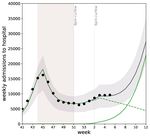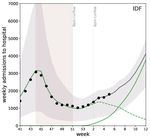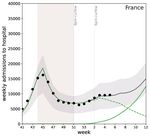IMPACT OF JANUARY 2021 SOCIAL DISTANCING MEASURES ON SARS-COV-2 B.1.1.7 CIRCULATION IN FRANCE - EPICX LAB
←
→
Page content transcription
If your browser does not render page correctly, please read the page content below
Impact of January 2021 social distancing measures on SARS-CoV-2 B.1.1.7 circulation in France Report #29 [previous reports at: www.epicx-lab.com/covid-19.html] Laura Di Domenico1, Chiara E. Sabbatini1, Giulia Pullano1,2, Daniel Lévy-Bruhl3, Vittoria Colizza1,* 1 INSERM, Sorbonne Université, Pierre Louis Institute of Epidemiology and Public Health, Paris, France 2 Orange Labs, Sociology and Economics of Networks and Services (SENSE), Chatillon, France 3 Santé publique France, Saint-Maurice, France *vittoria.colizza@inserm.fr 14/02/2021 (DATA UP TO 07/02/2021) RESUME Compte tenu de nouveaux variants et de l’incidence élevée enregistrée en France, les mesures de distanciation sociale ont été progressivement renforcées en janvier 2021. En utilisant un modèle mathématique à 2 souches calibré sur les estimations de la première enquête Flash pour la circulation du variant britannique (B.1.1.7), nous avons estimé que ces mesures ont conduit à la stabilisation des hospitalisations, résultante d’un équilibre entre le recul de la souche historique (celle en circulation avant l’arrivé du variant; taux de reproduction effectif estimé
INTRODUCTION Given the concern for the new variants1,2 and the high incidence recorded in France, measures of social distancing were progressively strengthened in January 2021. With a nationwide 8pm-curfew since mid- December, curfew was anticipated at 6pm in several departments at different dates in early January, due to deteriorating indicators. To further limit SARS-CoV-2 spread, French authorities extended the 6pm- curfew nationwide on January 16, with renewed recommendations for telework and the use of preventive measures. On January 31, these measures were further strengthened through heightened controls and closure of commercial centers. Using a 2-strain age-stratified transmission model3 integrating mobility data, fitted to hospital admissions, and calibrated to the estimated B.1.1.7 prevalence, we evaluated the impact of January 2021 social distancing measures on the two strains, and provide projections for B.1.1.7 dominance. Our results are validated independently with the preliminary estimates of the Flash2 survey conducted on January 274. METHODS Transmission model. We used the model developed by INSERM to respond to the COVID-19 pandemic3,5,6. The model was shown to capture the transmission dynamics of the epidemic3,5, was used to assess the impact of lockdown, exit strategies and reopening of schools5,6, and to evaluate the performance of the test-trace-isolate strategy3. The model was validated region by region against the estimates of three independent serological studies conducted in France3. It is based on a stochastic age-stratified transmission model, integrating demographic, age profile, and social contact data to account for age- specific contact activity and role in COVID-19 transmission. It integrates mobility data to account for control measures and individual response over time. Disease progression is specific to COVID-19 and parameterized with current knowledge to include presymptomatic transmission, asymptomatic and symptomatic infections with different degrees of severity (paucisymptomatic, with mild symptoms, with severe symptoms requiring hospitalization). Four age classes are considered: [0-11), [11-19), [19-65), and 65+ years old (children, adolescents, adults, seniors). A reduced susceptibility was considered for children and adolescents, along with a reduced relative transmissibility of children, following available evidence. Details of the model can be found in Ref.3. SARS-CoV-2 2-strain model. The model was extended to describe the circulation of two SARS-CoV-2 variants – the historical strain and the B.1.1.7 variant. Variant circulation was initialized based on Flash1 survey estimated prevalence7. Complete cross-immunity and 50% transmissibility increase (range: 40- 60%) were considered based on available knowledge8,9. The model is fitted to daily hospital admission data through a maximum likelihood approach, up to February 7, 2021. We considered mainland France (3.3% B.1.1.7 variant prevalence on new cases on January 7-8) and Île-de-France, the region reporting the highest penetration (6.9%). 2 epicx-lab.com
Model projections. We explore different scenarios of epidemic activity starting week 6. We considered projections based on the fit to daily hospital admission data up to w05, alongside a scenario assuming a relaxation of social distancing (10% increase in the effective reproductive number) and one assuming a strengthening of the measures (10% decrease). Validation. We used the preliminary estimates from the Flash2 survey4 (January 27) for validation. 7,657 PCR positive samples were analyzed out of 95,306 samples collected on January 27 by participating laboratories. S-gene target failure was identified in 428 cases out of 3,065 positive cases analyzed through Thermo Fisher, leading to an estimated 14% of S-gene target failure in France, and 19.5% in Île- de-France. As genome sequencing is still undergoing, we use these data and estimate B.1.1.7 penetration as a 70% to 100% proportion of S-gene target failure percentages of positive tests, given that 70% was the proportion estimated in the Flash1 survey. Estimated ranges for the territories under study are: 9.8- 14% in France; 13.7-19.5% in Île-de-France. RESULTS Strengthening Relaxation Estimated of SD measures of SD measures Figure 1. Projected weekly hospitalizations NAQ due to SARS-CoV-2 historical strain and B.1.1.7 variant in France and Île-de-France. From left to right: scenario assuming a strengthening of social distancing (SD) measures from w06, compatible with the situation experienced in the last weeks of the second lockdown; scenario based on estimates up to w05 and assuming no additional changes; scenario assuming a relaxation of social distancing measures from w06, compatible with the situation in early January. Dots correspond to weekly hospitalization data used for fitting the model. The solid black curve refers to the overall trajectory, due to the concurrent circulation of the historical strain (dashed green curve) and B.1.1.7 variant (solid green curve), assuming 50% increase in transmissibility (40% and 60% increases are shown for sensitivity in the SI). The shaded area around the curve corresponds to the 95% confidence interval; it is not shown for the single strains, for the sake of visualization. The second wave is shown for reference, together with indications of the timing of social distancing measures. 3 epicx-lab.com
% B.1.1.7 France IDF % B.1.1.7 Flash survey estimates Figure 2. B.1.1.7 projected prevalence over time and estimated dominance week in France and and Île-de-France. Left and center: estimated percentage of B.1.1.7 cases over time, assuming 50% (range 40-60%) increase in transmissibility for the variant. Points represent the consolidated estimates from Flash1 survey; point-lines represent the preliminary estimates from the Flash2 survey. We considered S-gene target failure percentages of positive tests for each territory4 and estimated the proportion of B.1.1.7 between 70% (Flash1 survey’s proportion) and 100% (indicated with the point). Right: estimated week of B.1.1.7 dominance, assuming 50% (range 40-60%) increase in transmissibility for the variant, and considering the estimated scenario (middle point) and the scenarios with strengthening (lighter color, left point) and relaxation (darker color, right) of social distancing measures. KEY FINDINGS • Based on the estimated B.1.1.7 prevalence in early January, the model predicted that the observed plateau results from the counterbalance between two opposing dynamics: a decreasing circulation of the historical strain (with effective reproductive numbers "#$ =0.95 (0.94-0.96), "%&# =0.95 (0.93-0.97)) opposed to the exponential increase of the variant. Control measures were not enough to lead to a decline in the variant spread due to its more efficient transmission. • The rapid increase of B.1.1.7 prevalence over time estimated by the model is in agreement with the preliminary estimates resulting from the Flash2 survey. The model predicts that the variant would become dominant in week 9 (8-9) in France, and 7 in Île-de-France. Changes in social distancing would negligibly affect the estimated dominance date, as the measures would have a concurrent effect on both strains. Estimated variations are larger for changes in the assumed increase in variant transmissibility. • Strengthening social distancing measures show clear advantages in gaining time to extend the plateau before the expected resurgence of cases. The scenario proposed here, with a 10% reduction in current " , is less efficient than the early phase of the November mild lockdown, with schools open. It corresponds to the situation estimated in the later phase, when relaxation emerged, mobility increased and telework progressively reduced. The additional measures taken 4 epicx-lab.com
on January 31, a possible slowdown induced by winter school holidays, as well as a strengthening of the test-trace-isolate strategy5 may contribute to further stretch the current plateau. • In absence of more rigorous and intensified social distancing, B.1.1.7 will drive a rapid growth in the next weeks, with an earlier timing in those regions reporting a large presence of the variant (e.g. Île-de-France). Increasing vaccination coverage is key10, but its mitigating impact is expected to become important starting April, according to estimated rollout plans and assuming efficacy only against symptomatic forms of infection (see Appendix). LIMITATIONS • The study considers the strengthening of social distancing, but not stronger measures as a lockdown. Lockdown was considered in a previous report, see Report #28. • The model does not explicitly consider winter school holiday. However, their possible slowdown effect is included in the scenario with strengthening of social distancing. • Increased transmissibility was assumed from prior estimates in the UK8,9,11, compatible with those from other countries12. Similar estimates from French data will help update projections, however validation with the second genomic survey already suggests a good agreement with assumptions. We did not consider additional differences between the variant and the historical strain, such as increased severity. • This report does not take into account other variants, as they are estimated at an overall lower penetration. Their circulation will concur to the expected case surge. ACKNOWLEDGMENTS We thank Santé publique France for the access to Flash survey preliminary estimates. This study is partially funded by: ANR projects DATAREDUX (ANR-19-CE46-0008-03), EVALCOVID-19 (ANR-20- COVI-0007); EU H2020 grants MOOD (H2020-874850) and RECOVER (H2020-101003589); REACTing COVID-19 modeling grant. REFERENCES 1. ECDC. Risk Assessment: Risk related to spread of new SARS-CoV-2 variants of concern in the EU/EEA. European Centre for Disease Prevention and Control https://www.ecdc.europa.eu/en/publications- data/covid-19-risk-assessment-spread-new-sars-cov-2-variants-eueea (2020). 5 epicx-lab.com
2. Investigation of novel SARS-CoV-2 variant: Variant of Concern 202012/01. GOV.UK https://www.gov.uk/government/publications/investigation-of-novel-sars-cov-2-variant-variant-of- concern-20201201. 3. Pullano, G. et al. Underdetection of cases of COVID-19 in France threatens epidemic control. Nature 590, 134–139 (2021). 4. Santé publique France. COVID-19 : point épidémiologique du 4 février 2021. /maladies-et- traumatismes/maladies-et-infections-respiratoires/infection-a-coronavirus/documents/bulletin- national/covid-19-point-epidemiologique-du-4-fevrier-2021. 5. Di Domenico, L., Pullano, G., Sabbatini, C. E., Boëlle, P.-Y. & Colizza, V. Impact of lockdown on COVID- 19 epidemic in Île-de-France and possible exit strategies. BMC Med. 18, 240 (2020). 6. Di Domenico, L., Pullano, G., Sabbatini, C. E., Boëlle, P.-Y. & Colizza, V. Modelling safe protocols for reopening schools during the COVID-19 pandemic in France. Nature Communications in press (2021) doi:10.1101/2020.05.08.20095521. 7. Santé publique France. COVID-19 : point épidémiologique du 28 janvier 2021. https://www.santepubliquefrance.fr/maladies-et-traumatismes/maladies-et-infections- respiratoires/infection-a-coronavirus/documents/bulletin-national/covid-19-point-epidemiologique- du-28-janvier-2021. 8. Davies, N. G. et al. Estimated transmissibility and severity of novel SARS-CoV-2 Variant of Concern 202012/01 in England. medRxiv (2020) doi:10.1101/2020.12.24.20248822. 9. Volz, E. et al. Transmission of SARS-CoV-2 Lineage B.1.1.7 in England: Insights from linking epidemiological and genetic data. medRxiv 2020.12.30.20249034 (2021) doi:10.1101/2020.12.30.20249034. 10. European Centre for Disease Prevention and Control. Integrated COVID-19 response in the vaccination era. https://www.ecdc.europa.eu/en/publications-data/integrated-covid-19-response- vaccination-era (2021). 11. Leung, K., Shum, M. H., Leung, G. M., Lam, T. T. & Wu, J. T. Early transmissibility assessment of the N501Y mutant strains of SARS-CoV-2 in the United Kingdom, October to November 2020. Eurosurveillance 26, 2002106 (2021). 12.Christian L. Althaus et al. Transmission of SARS-CoV-2 variants in Switzerland. https://ispmbern.github.io/covid-19/variants/index.pdf. 6 epicx-lab.com
APPENDIX Impact of vaccination Here we show model projections considering the introduction of vaccines on the estimated scenario for France. Following estimated plans for rolling out the vaccination campaign, we simulate the administration of 100,000 or 200,000 doses per day in France, prioritized to the older age class. We consider that this rhythm of vaccination is in place from week 4. We assume 90% vaccine efficacy in preventing symptoms following the administration of the second dose, 2 weeks after the first. We consider a conservative assumption of no efficacy on transmission or on susceptibility to be infected, in lack of estimates. Even with the higher daily rhythm (200,000 doses administered per day), vaccination has a minimal effect in reducing the number of hospitalizations in the timeframe under study (Figure S1). This result may be conservative for two reasons. First, we do not consider an efficacy in transmission or protection from infection. Second, priority is given to 65+ whereas vaccination is currently being rolled out in the 75+ age class in the timeframe under study, characterized by a higher hospitalization rate. As our model does not break down further age classes above 65 years of age, vaccination cannot account for the higher advantage in targeting older age classes. 100,000 doses/day 200,000 doses/day Figure S1. Impact of vaccination on the projected weekly hospitalizations due to SARS-CoV-2 historical strain and B.1.1.7 variant. Solid line refers to the estimated scenario for France with 50% increase in transmissibility of the B.1.1.7 variant, without vaccination (as in first row, central panel of Figure 1). Dotted line refers to the same scenario, with the introduction of vaccines. Rhythm of vaccination from w04 is 100,000 doses administered per day (left) and 200,000 doses administered per day (right). Dots correspond to weekly hospitalization data used for fitting the model. The shaded area around the curve corresponds to the 95% confidence interval; it is shown only for the scenario without vaccination, for the sake of visualization. 7 epicx-lab.com
You can also read



























































